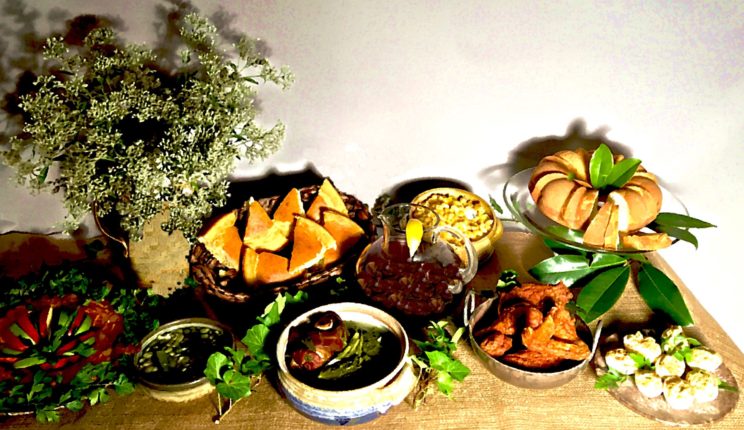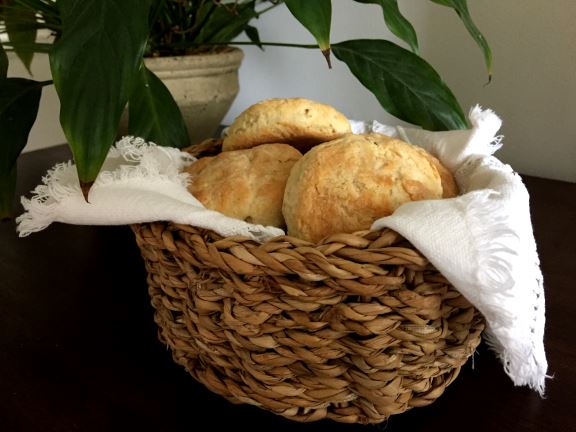The Southern Spread

by deborah fagan carpenter
Our culture, our history, our spirit, and our hospitality are some of the ingredients. Southern foods are heavily influenced by African, English, Scottish, Irish, French, and Native-American cuisine, and although most of them are served across the country today, there are foods in the U.S. that are strictly thought of as SOUTHERN. There’s Creole, Lowcountry and Floribbean, and I’m not sure where fried chicken and deviled eggs fit into the mix, but to be certain, they perform with a southern accent. In “The Southern Spread,” we’re exploring southern foods and traditions.
This Month’s Feature:
Biscuits 101

It’s a cryin’ shame to have lived in the South for seven decades and not know how to make biscuits. To southerners, cornbread and biscuits are what baguettes are to the French—a necessity. I’m confessing that until recently, I hadn’t even tried to make them. But, beginning in January, I vowed to rectify that affront to southern cooking by a nearly 70-year-old Southerner, and I set about to learn how to make respectable biscuits.
Because there is no yeast involved in the making, thus no long time spent waiting for them to rise, biscuits fall under the category of “quick breads.” The Southern staple didn’t originate in the South, or even in the United States. Biscuits were found in Africa, Europe, and Asia long before we existed, but rather than the crusty exterior and soft, flaky interior that we’re used to, they were unleavened, so they were, and for a large part still are, flatter and “hardish.” British scones, with their browned crust and soft interior, are similar to what we think of as biscuits. (Typically though, if someone in an English-speaking country offers biscuits with your tea, they’re probably serving something that is more like cookies or small cakes.)
Today, the light, fluffy biscuits that originated with the slave cooks in Southern plantation kitchens, are commonly enjoyed in the rest of the country. In the South, biscuits accompany meals, but probably the most popular way to eat them is for breakfast slathered in butter, drenched in honey or molasses, covered in country gravy, or, sliced in half with ham or bacon in the middle. Beaten biscuits, where the dough literally has air beaten into it with a mallet, a rolling-pin, or even a hammer is most definitely a Southern thing.
With amounts varying from recipe to recipe, the ingredients for making biscuits are merely a combination of flour, butter and/or shortening, baking soda and/or baking powder for leavening or self-rising flour, and milk, buttermilk, sour cream, or water. That’s it. How hard can this be?
Well, it turns out that as simple as these combined elements are, they’re temperamental. Biscuit batter doesn’t like to be “messed with” too much while mixing and rolling or patting, or, it results in toughness. Avoiding “messing with it too much” is harder than you think. Also ill-advised is twisting the cutter, and for the biscuits to fully rise it’s best to cut straight down. I can’t fathom what difference that can possibly make, but hey, I’m a beginner and I remain open-minded.
Because I’m currently experiencing pain in my wrist and thumb, the hardest part of the process for me is cutting the butter and/or shortening into the flour. Severe discomfort ensues from incorporating it with a pastry blender, using two knives, or grating frozen butter. But, I persevere. Determined to master this biscuit-making obsession, I’ve experimented with blending the butter and flour using a food processor. It’s tricky because you don’t want the butter to get warm, so as few as possible quick pulses is critical. As it happens, Martha (that would be Martha Stewart) approves of this method! It’s a game changer!
Every Southern cook and cookbook has a recommended way to make biscuits so I won’t include any recipes here. It’s not difficult to find recipes for sweet, dessert biscuits, Angel biscuits, herbed biscuits, cheese biscuits, and of course, the aforementioned beaten biscuits. Although there are some helpful hints suggested from a variety of sources that I will share.
- Work quickly when combining the cold butter with the flour so the butter won’t get warm.
- Biscuits made using buttermilk as the liquid have fewer calories than those using regular milk.
- Create a well in the middle of the flour/butter mixture and add the liquid there.
- Use as little flour as possible on the surface on which you roll the dough because it contributes to making the biscuits tough.
- If you roll the dough more than twice, it will also result in tough biscuits. Instead, with your hands, form the remaining dough into a semblance of a biscuit.
- Flour the cutter for ease in cutting.
- If the biscuits are allowed to touch during baking, the result is that they are taller and have softer sides. For crisper ones, leave about an inch in-between.
- Rotate the cooking sheet halfway through cooking time to achieve even cooking and browning.
Four months in, and I’m unwavering in my biscuit making endeavor. May 29th is National Biscuit Day. Who knows? By then I might be good enough at this thing to serve biscuits to a biscuit connoisseur.
Deborah Fagan Carpenter
Photos: Deborah Fagan Carpenter



Freeze the butter then grate it on the coarse side of a box grater. Works grate! I mean great!
Ha!! Thanks, Terry! I think that’s a great idea for most people but I have something wrong with my hand and wrist right now, and that method was excruciating for me. Thus the food processor! When my hand pain subsides, I’ll try that way again! Thanks for reading the article!!